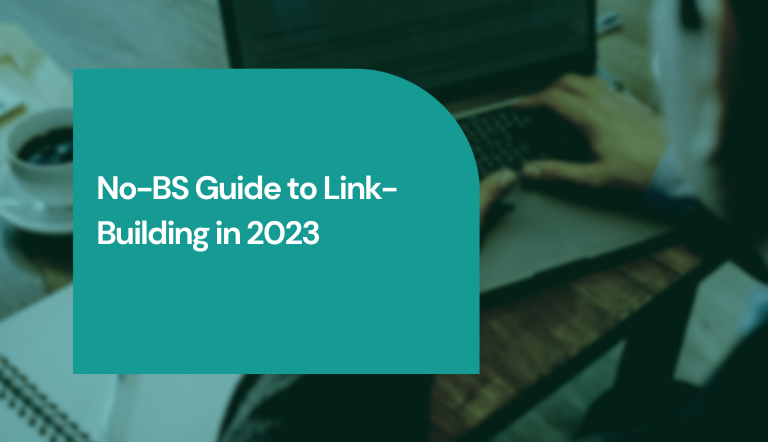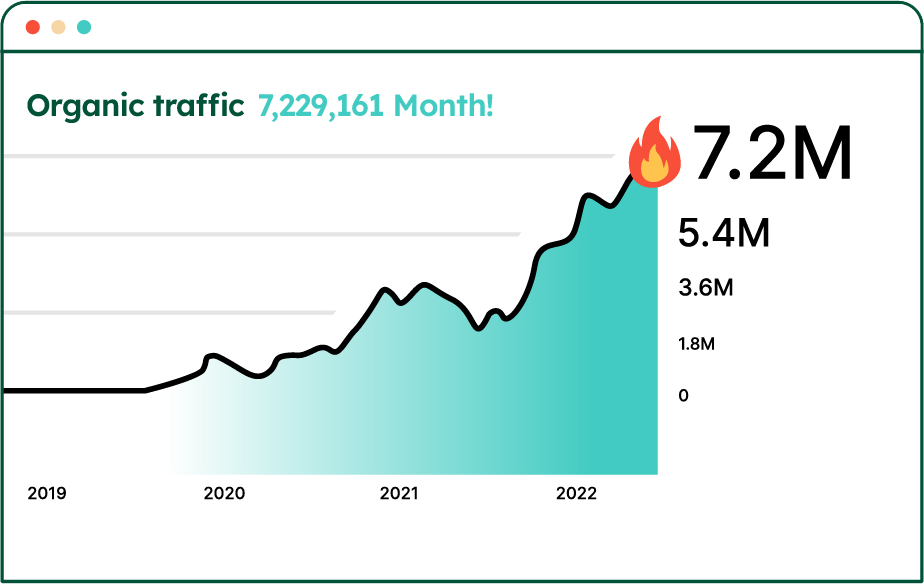The problem: a LOT of the link-building guides on the internet are outdated or just impractical.
The skyscraper technique (hey, you linked to resource A, I have resource B, pls link to me) doesn’t work anymore.
Everyone and their pet dog do this kinda outreach, and bloggers/site owners just kinda don’t care anymore.
I’ve built over 1,000 links in the past year for several client websites and learned a TON in the process.
In this post, I’ll do a very comprehensive review of link-building in 2023 and explain what really works.
This’ll be a long one, so grab a coffee, and let’s dig in!
Let’s go!
(If you loved this post, I run a no-bs SEO subreddit, /r/seogrowth, check it out!)
Should I do link-building in the first place?
Starting with the most important question here: do you need link-building at your current stage?
You should ONLY do link-building once you have:
- A solid SEO strategy in place
- A decent number of blog posts / resources
Otherwise, you’ll be building links on hard more, and you won’t be generating results that are good enough for it to the worth your while.
You should also avoid SEO as a marketing channel overall unless you’re ready to commit to long-term work. While it IS possible to sometimes get results within 1-3 months of SEO work, those cases are pretty rare.
If you need revenue TOMORROW or you go bankrupt, try content marketing, PPC, direct sales, email marketing, or any other channel.
Now that we’ve got that out of the way…
The BS
There is a TON of outdated info about link-building on the net.
Here’s what DOESN’T work these days:
- Forum link-building. Most forums no-follow all outgoing backlinks.
- Web 2.0 links. People spamming their links on Reddit are 100% wasting their time. Google can tell a user-generated content site apart from all other sites. Hence, links from Reddit, Medium, etc. are devalued big-time.
- Blog comment links. Most blogs no-follow blog comment links, so that’s a waste of time too.
- PBNs (ish). Well-built PBNs work just fine. The PBNs you bought from some sketchy forum, though, will crash your site big time.
- Link farm backlinks. Links from sites built just to sell backlinks.
And before some of you go:
“But Nick, I build web 2 links and rank just fine!”
Sure you do! But you’re most likely not ranking because you’ve been building web 2/blog comment/whatever links.
If you were building REAL backlinks, you’d rank faster.
Another common misconception is that paying for links is going to get you penalized or it just doesn’t work.
The reality: Unless you’re buying sketchy links, or you’re building links in a sketchy way (e.g. building 20 links to ONE page exclusively in a short timeframe), there’s no way for Google to tell a backlink was paid for.
A lot of industries are just pay-to-play and nothing else. If you’re in CBD, forex, gambling, etc. you’ll 100% have to pay for backlinks or your competitors are going to outrank you big-time.
So what DOES work?
Real links from real, topically related websites.
E.g. if you run a fitness site, you’d benefit from getting links from the following sites:
- Authoritative fitness blog/media
- Small-time yoga blog
- Weight loss blog/media/site
You get the drift. As long as the site publishes topically related content to yours, then that’s a good link prospect.
Media backlinks also work even if they’re not topically related. E.g. Mashable, Forbes, etc.
Some green flags that a backlink is high quality are:
- Their site is driving 1,000+ traffic from Google
- Site publishes genuine, high-quality content
- Site does NOT publish dozens of guest posts per month or sells backlinks en masse
- Site has NOT been penalized lately (i.e. they didn’t lose a big chunk of their traffic)
- Site does NOT publish backlinks/guest posts from gambling sites
- They have an “about us” page & there’s a real person behind the blog
Link-building is niche-dependant
Before we dive into the actual process, thought this was important to cover.
How you do link-building SERIOUSLY depends on your niche.
#1. If you’re blogging about, say, yoga then it’ll be much easier than. There are a TON of blogs that are topically related to yours and can link back to your site:
- Fitness blogs
- Yoga blogs
- Weight loss blogs
These sites are also a lot more approachable. They’re usually run by amateurs and w/ a good personalized email, they’ll be happy to link to you.
#2. If you’re blogging in B2B, on the other hand, things are a bit more give-and-take.
Websites will want something from you for a backlink. Usually, that’s:
- A high-quality guest post
- Partnership in some way
- Direct or indirect backlink exchange
So tl;dr, link-building in B2B is mostly relationship-building.
#3. If you’re in a competitive niche (CBD, VPN, etc.) then it’s pay-to-play. A good outreach game will definitely help, but you’ll have to pay a good $ for them to place your backlinks.
The link-building process
Now let’s talk practice!
The typical link-building process, from a top-down perspective, looks like this:
- You come up with a link-building campaign type. At this stage, you decide on what you’re pitching / promoting. For your campaign to be more successful, you want to promote a useful resource or blog post. People are hella more likely to link to your resources than your product pages. Also, I wouldn’t recommend building links unless you already have some content / SEO strategy in place.
- VA collects link-building prospects based on certain criteria. E.g. blogs about, say, scrapbooking, tech reviews, whatever. Lots of ways to do this, but I’ll cover it in detail below.
- VA finds the right point of contact for each prospect. They extract their email / contact info using some tool.
- Copywriter creates a personalized outreach template for the campaign. You DO NOT want to copy-paste something from the internet.
- Link-building specialist starts the outreach campaign. They keep track of responses and do what they need to do to secure link placements.
Let’s go through each step of this process one by one:
#1. Campaign type
The most common types of link-building campaigns are:
- Link insertions
- Guest posts
- Broken link-building
- Unlinked mention
#3 and #4 are very situational and require their own approach, so we’ll skip that entirely.
Same with guest posts. Those require a bit more manual emailing and pitching, so let’s push that off for another time.
But tl;dr here is this: you review the website’s guest posting policy and get a content writer to create a tailored pitch.
In this post, let’s stick to link insertions since that’s the most scalable tactic. You don’t need a fresh guest post written for every backlink you want to build.
Now, from there, you want to create a cool resource that people will want to link to.
Some good examples:
- Infographic they can insert into an existing blog. e.g. Top 21 Benefits of Weight-Lifting As Proven by Science
- Long-form content. E.g. Top 101 Productivity Tips from Top Professionals
- Fresh research. E.g. We surveyed 1,000 of our users about their dating preferences. Here are our findings.
- Unique tool. E.g. Free tool to analyze your competitor’s backlink profile in a click.
Not sure what’s a good link magnet for your niche?
Run your competitors through Ahrefs and check their Top Pages by Links. You’ll see which of their pages are driving the most backlinks.
Once you’ve got your link magnet down, time for step 2:
#2. Link prospecting
Your VA collects hundreds of prospects that fit your criteria.
So step 1 – you HAVE TO have a VA do this. The process is extremely time-consuming and if you, as a founder, are spending time on this, you won’t have much time for anything else.
Now as for prospecting, there are a TON of ways to go about this.
The tactics:
- Pick several blog categories that you’d benefit from getting backlinks from. E.g. fitness => yoga, weight loss, dieting niches, and so on. Prospect for such blogs w/ basic Google queries. E.g. “yoga blog,” “diet blog,” etc.
- Pick out articles that would benefit from a long to your resource. E.g. if you’re promoting, say, a bachelor party checklist infographic, you can look up keywords about organizing bachelor parties and extract those prospects. “Organize bachelor party,” “bachelor party ideas,” “bachelor party examples,” etc. Pro tip – you’re more likely to get backlinks from articles ranking page 2+ VS ones ranking on page 1.
- Pick out articles that can organically mention your product(s). E.g. find articles about “top X gifts for year Y anniversary”
- Run your competitors through Ahrefs and extract their backlink profile. If someone linked to your competitor, chances are, they might link to you, too (as long as your email copy is good).
- Run sites that already link to you through Ahrefs/semrush and extract their backlink profile(s). Small-time bloggers usually link to each other so chances are, these sites will be willing to link to you, too.
Most of these can either be done manually by a VA, automated via ScrapeBox or Link Assistant, or by using Pitchbox.
Don’t have a VA? You can hire one on OnlineJobs.ph.
#3. Finding the point of contact
This one’s pretty simple. Your point of contact depends on the size of the site:
- Big media => you want to contact the author of the post specifically
- Company of any size => you want to contact the head of content, editor-in-chief, or head of digital marketing
- Personal or small-time blog => owner of the blog
Teach your VA how to find the right point of contact.
From there, they can use Hunter to find the email of the contact.
If Hunter does NOT find the email, you can simply find the email format (e.g. [firstname]@[company] dot com) and logically guess the email of a given prospect.
Note: if you’re reaching out to small blogs, general emails like info @ company dot com can still work.
If you’re reaching out to a company, though, or a media, general email basically means that no one’s going to read your outreach.
#4. Creating personalized email copy
One of the most common mistakes people make with link-building is copy-pasting a template from the internet.
They read an article on link-building on some top blog like Ahrefs or Backlinko, find a template, copy-paste, send it to 200 people, and wonder why it didn’t work.
Here’s why:
Literally, everyone does the same exact thing.
It goes a little something like this:
Hey [Name],
I just stumbled on your blog while looking for articles about [topic].
I (totally for real for real) read your article and it’s like, really really cool!
But you know what it’s lacking?
A link to my site, eyyy.
Pls link?
Bloggers/site owners get a TON of these emails.
It’s SO DAMN GENERIC that even if you’re pitching the best resource ever created, you’ll get ignored.
So what you gotta do is create your own template for any given campaign you’re pushing.
Here are some tips on how to create great outreach copy.
For your subject line:
- Mention the prospect’s name/site name. E.g. [Name], recipes in [site] are mouthwatering!
- Tailor it to the niche. E.g. [name], I’m stuck in bronze, send help
- Make it look like a personal email. E.g. Question, [name]? Intro – [name] <> [name], etc.
And the rest for your body copy:
- Give a compliment about their site/content that FEELS like a genuine compliment, but applies to most of your prospect list (sorry not sorry). E.g. “Your recipes are mouthwatering! I’m planning on giving [latest recipe] a try for dinner with my [wife/husband]“
- Mention jokes/references that someone in that niche might find funny or punny. E.g. As a budding green thumb enthusiast, I wanted to take a moment to leaf you a message and hopefully plant a few seeds of inspiration.
- Make it about something they mentioned in their post. Get a VA to make a custom column and add details from the post. E.g. “Your post about 10-anniversary gifts really saved me in a clutch! I’m planning on getting my missus a [gift from a listicle]“
- Keep it human. No corpo lingo. Your outreach emails should look like something you’re sending to your BFF.
- Finally, (preferably), don’t include images or links in your outreach emails. They hurt deliverability. If you have to include a pitch to a resource, you can make an exception (or add a CTA for “drop me a thumbs up and I’ll send you the post“).
Optionally, at the end of the outreach email, you can add an offer of what you can give in exchange for that backlink. Some examples I’ve seen that work:
- We’ll link back to your site from a future guest post on a third-party site.
- We’ll share your content with our Twitter audience of X people.
- We’re going to literally pay you money for the link.
- Let’s do a backlink exchange.
- We’ll give you free access to our software for X months.
- We’ll give you X free credits to our SaaS tool.
#5. And launch!
Once you’ve got your prospects and email copy ready to go, launch your campaign.
Some info on the technical stuff re: the outreach process:
- Use a dedicated outreach domain. DO NOT use your main domain. Some peeps on the internet WILL report you for spam just because they had a bad day. If this happens, your email deliverability for your main domain will suffer.
- Instead, use a dedicated outreach domain. E.g. if your brand is “brand dot com”, you can do “brand PR dot com”
- Use either Google Workspace, private email, Office 365, or Zoho to create those private emails.
- Use a tool to warm up the email. Such tools automatically send/open/reply to emails from new domains to “warm them up.” This helps improve the deliverability rates of your fresh emails. Warm up for around 2 weeks per inbox.
- Don’t send more than 60 emails per day per email. Yes, this includes follow-ups. The more you go over this limit, the more likely it is for the inbox to get “burned” and your deliverability to tank.
- Speaking of follow-ups, do NOT do more than 2 follow-ups per email. If the prospect doesn’t reply after 2 emails, they’re probably not interested at this time.
- Finally, don’t include links in your outreach emails. This helps improve deliverability. If you’re pitching a resource, you can make an exception there (or you can add a CTA like, “just drop me a thumbs-up and I’ll send you a link”).
How to build backlinks when you’re broke
I’ve had a ton of people ask me about this before so thought I’d cover it in a dedicated section.
In a niche where links cost cash AND you’re broke?
Fortunately, there are options to bypass that backlink sponsorship fee.
- Do value-based guest posting. Most guest posts people pitch are, practically speaking, trash. 500 words, 0 value, and usually AI-generated. Pitch your prospects your experience and expertise and offer a post that they can actually benefit from. Good example is picking out a keyword they want to target and writing a guest post targeting that. That’s value!
- Use HARO, Terkel, or similar platforms. Basically, these are platforms that match journalists with sources. They’re a great way to sometimes land very high authority backlinks, or build up some homepage backlinks without too much hassle/outreach.
- Make friends with other bloggers. For real. Follow them on Twitter or LinkedIn. Engage with their content. Then shoot them a DM and offer a backlink collaboration. E.g. link exchange, ABC link exchange, etc. Friendship is magic. While this approach is time-consuming, it’s ideal if you’re building a niche site and don’t have a lot of existing backlinks.
Best tools for building backlinks
Now, let’s talk tools. You ain’t doing all this manually:
- Semrush/Ahrefs as a general SEO tool. You can use both to extract competitor backlink profiles. You can also use either to evaluate whether a certain site is a good backlink prospect.
- Outreach tool. If you’re just getting started with link-building, Snov is the most value deal there is (comes with email warmup, email finder credits, outreach tool, etc.). If you’re looking for the best-in-class tool, that would be Pitchbox. Must-have if you’re building links at scale or run an agency.
- Hunter.io is great for finding prospect emails.
- Link Assistant or Scrapebox for help with prospecting.
- Warmup Inbox for email warmup.
- MailGenius to check email health.
Might’ve missed a couple, but this is the gist. You can also use ChatGPT to write your email first lines if you’re feeling spicy. Think there was a dedicated tool for this too, though.
FAQ
Got more questions? I foresaw this with my third eye of truth and 3rd coffee of the day. Hence, the FAQ section.
#1. How many emails should I send per day?
This depends on the niche. Estimate your win rate per 100 emails. Then, work backward from there. If you win 5 links from 100 emails, and you want 20 links a month, you need 400 emails sent per month.
#2. How long does it take for backlinks to kick in?
Links impact your site 1-3 months after being built (usually).
#3. How can I calculate the ROI of my link-building?
It’s really hard to estimate the dollar value of a given link, so hard to figure out link-building ROI.
That said, if links can take you from page 2 to the top 3 rankings for your target keyword, very good chance you’ll get good ROI.
If you’re targeting the right keywords, anyway.
This is literally why the catchphrase of SEO is “well, maybe, yes, but sometimes no, it depends…”
#4. Can I rank without backlinks?
This depends on the niche.
If there’s not much competition, yeah, that’s possible.
Otherwise, link quality/quantity will determine if you rank top 3, or page 2. Links also determine how fast you’ll rank.
#5. Will I get penalized for exchanging links?
According to a study by Ahrefs, most top websites have reciprocal links.
That’s just how the internet works. Unless all you have is direct link exchanges with hundreds of sites, you should be good/safe.
#6. Google said paying for links is bad, what do? 🙁
Paying for links is extremely common and most link-builders do it. If you’re doing it smart, you won’t get penalized / affected negatively in any way.
#7. How do I get backlinks from big media sites / authority sites?
Either through connections or digital PR, but that’s a completely different topic VS conventional link-building.




